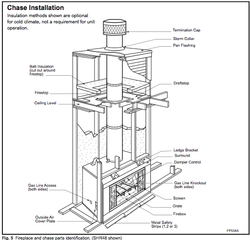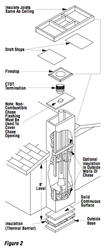E
elkimmeg
Guest
There has been a lot of discussion about chase and fire place bump out construction. Here is the best description I have found.
CONSTRUCTING A CHASE
Construction of the chase may vary with the type of build-
ing. These instructions are not substitutes for the require-
ments of local building codes. Local building codes MUST
be checked.
Chases should be constructed in the manner of all outside
walls of the home to prevent cold air drafting problems. The
chase should not break the outside building envelope in any
manner.
Walls, ceiling, base plate and cantilever floor of the chase
should be insulated. Vapor and air infiltration barriers should
be installed in the chase as per regional codes for the rest of
the home. Additionally,, that the inside surfaces be sheet rocked and taped
(or the use of an equivalent method) for maximum air tight-
ness.
To further prevent drafts gas line holes and other openings
should be caulked with high temp caulk or stuffed with un-
faced insulation. If the appliance is being installed on a ce-
ment slab, we recommend that a layer of plywood be placed
underneath to prevent conducting cold up into the room.
specifications in manual.
• Locate and install appliance to all
clearance specifications in manual.
CONSTRUCTING A CHASE
Construction of the chase may vary with the type of build-
ing. These instructions are not substitutes for the require-
ments of local building codes. Local building codes MUST
be checked.
Chases should be constructed in the manner of all outside
walls of the home to prevent cold air drafting problems. The
chase should not break the outside building envelope in any
manner.
Walls, ceiling, base plate and cantilever floor of the chase
should be insulated. Vapor and air infiltration barriers should
be installed in the chase as per regional codes for the rest of
the home. Additionally,, that the inside surfaces be sheet rocked and taped
(or the use of an equivalent method) for maximum air tight-
ness.
To further prevent drafts gas line holes and other openings
should be caulked with high temp caulk or stuffed with un-
faced insulation. If the appliance is being installed on a ce-
ment slab, we recommend that a layer of plywood be placed
underneath to prevent conducting cold up into the room.
specifications in manual.
• Locate and install appliance to all
clearance specifications in manual.


 hh:
hh:  I told you not to slam the front door again...we gotta get outta here sometime today...CAA MAYN
I told you not to slam the front door again...we gotta get outta here sometime today...CAA MAYN


